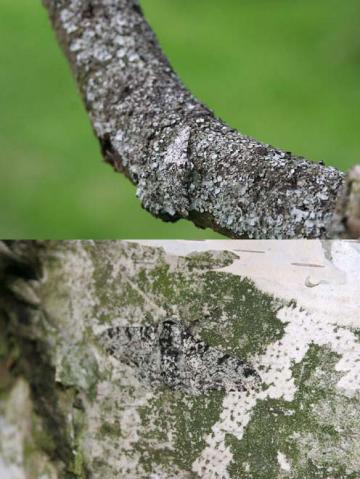Summary of problems:
Peppered moths do rest on trunks. Kettlewell placed moths on both branches and trunks, covering the spectrum of moth resting places.Full discussion:
Kettlewell was aware that peppered moths rested on both trunks and branches. In Kettlewell s experiments, he actually placed the moths on trunks and branches, in relatively unexposed locations, thus covering the natural resting places of the peppered moth.
In a comprehensive study of peppered moth resting places in the wild, fully 25% of moths were found resting on trunks (Majerus, 1998, cited above). Of the remainder, roughly 25% were found on branches, and 50% at branch/trunk junctions. Furthermore, in the branch/trunk junction category, the moths are actually resting on the trunks, 2-3 inches below the branch. In a later, extensive 6 year study 37% of peppered moths were found on trunks (Majerus, 2007, cited above).
 Peppered moths in situ: Peppered moths in their natural resting places on horizontal tree branches (above) and vertical tree trunks (below). From figures 4 and 5 in Michael E. N. Majerus (2009), "Industrial melanism in the peppered moth, Biston betularia: an excellent teaching example of Darwinian evolution in action," Evolution: Education and Outreach 2(1):63-74.
Peppered moths in situ: Peppered moths in their natural resting places on horizontal tree branches (above) and vertical tree trunks (below). From figures 4 and 5 in Michael E. N. Majerus (2009), "Industrial melanism in the peppered moth, Biston betularia: an excellent teaching example of Darwinian evolution in action," Evolution: Education and Outreach 2(1):63-74.It is important to note that Kettlewell performed several different experiments; direct observations, filmed observations of birds taking moths from exposed trunks, indirect observations of moth predation where moths were released onto relatively unexposed trunks and branches and allowed to chose their resting places, and mark-recapture experiments, where again moths were released onto relatively unexposed trunks and branches to choose their own resting places (Kettlewell, 1955, 1956, both cited above). So when Kettlewell put his moths on trunks and branches (Kettlewell, 1955, 1956), he was placing them where the majority of all moths rest naturally, as far as we can tell (even more if we count the trunk-resting moths at the trunk/branch junctions).
Michael Majerus has repeated Kettlewell s experiments using moths resting on the undersides of branches (Majerus 1998, 2007). In both cases, differential predation was found that confirmed Kettlewell s original observations. Furthermore, in Majerus s 6-year experiment, measured predation intensity at the experimental sites predicted the population frequencies of moths found in the wild (Majerus, 2007).
While the authors of Explore Evolution could not have been expected to have had access to Majerus s 2007 results, Majerus s 1998 results, as well as Kettlewell s description of the original experiments (Kettlewell, 1955, 1956) alone are enough to show that Explore Evolution is completely wrong on this point.
Since Kettlewell's original experiments were published, they have been independently replicated at least 6 times (See for example Grant 1999, Majerus 1998, and Majerus 2007, all cited above, for reviews). All of these experiments have addressed one or more criticisms of the original study, and all have broadly confirmed Kettlewell's experiments. Thus we can say that Kettlewell's experiments have stood the test of time.
An inquiry-based book could have used this history of successive investigations to explore the practice of science as a self-correcting enterprise, and the importance of replicability to the scientific process. Students could have been asked to devise their own experiments based on criticisms of Kettlewell's early work, and then teachers could reveal data from experiments like those performed by Majerus to evaluate the results of those new experiments. Instead, students are presented with erroneous critiques of Kettlewell's work, given none of the more recent vindicating evidence, and instructed to believe that this flawed exploration demonstrates a weakness in natural selection. In fact, it reflects only the weaknesses of Explore Evolution, and of its authors' approach to evolution and science in general.
